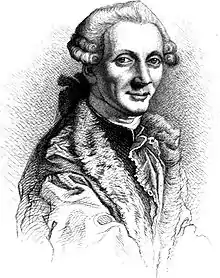Didon (Piccinni)
Didon (Dido) is a tragédie lyrique in three acts by the composer Niccolò Piccinni with a French-language libretto by Jean-François Marmontel. The opera is based on the story of Dido and Aeneas from Virgil's Aeneid as well as Metastasio's libretto Didone abbandonata (which Piccinni himself had set in 1770). Didon was first performed at Fontainebleau on 16 October 1783 in the presence of the French sovereigns, Louis XVI and Marie Antoinette. After being remounted at court twice, the opera had its Paris public premiere on 1 December 1783. It proved to be the composer's greatest success and was billed almost every year till 1826, enjoying a total of 250 performances al the Paris Opera.[1] Didon had some influence on Berlioz's opera on the same theme, Les Troyens.
| Niccolò Piccinni |
|---|
 |
Roles
| Role | Voice type | Premiere cast: 16 October 1783[2][3] |
|---|---|---|
| Didon, the Queen of Carthage | soprano | Antoinette Cécile de Saint-Huberty |
| Énée, a Trojan prince | tenor | Étienne Lainez |
| Iarbe, an African King | bass-baritone | Henri Larrivée |
| Phénice, a confidante of Dido | soprano | Adealaïde Gavaudan, cadette |
| Elise, Dido's sister | soprano | Mlle Joinville[4] |
| Un confident d'Iarbe, a confidant of Iarbas | bass-baritone | Louis-Claude-Armand Chardin ("Chardiny") |
| Pretres de Pluton, priests of Pluto | bass-baritones and tenors |
|
| Une ombre, the shade of Anchises | bass-baritone | Auguste-Athanase (Augustin) Chéron |
| Dido's followers, Carthaginian people, Trojan warriors: choir | ||
| Ballet – ballerinas: Marie-Madeleine Guimard, Peslin, Anne-Marguerite Dorival, Dorlay; male dancers: Maximilien Gardel, Nivelon, Laurent | ||
Synopsis

Dido, Queen of Carthage (Didon), falls in love with the Trojan warrior Aeneas (Énée), who has been shipwrecked on her shore. However, Dido is promised in marriage to the African king Iarbas (Iarbe). War breaks out between Aeneas and Iarbas in which the Trojan is triumphant. But Aeneas is warned by the ghost of his father, Anchises, that he must leave Carthage at once for Italy. The heartbroken Dido commits suicide by throwing herself on a funeral pyre. Her Carthaginian subjects swear eternal revenge on Aeneas' descendants, the Romans.
Recording
- Didon Soloists, Orchestra del Teatro Petruzzelli, conducted by Arnold Bosman (Dynamic, 2003)
References
Notes
- Lajarte, p. 337
- according to the original libretto
- Casaglia, Gherardo (2005)."Didon, 16 October 1783". L'Almanacco di Gherardo Casaglia (in Italian).
- Mademoiselle Joinville was successfully replaced in following performances by Anne-Marie Jeanne Gavaudan, l'aînée (cf: Correspondance littéraire, philosophique et critique de Grimm e de Diderot, depuis 1753 jusqu'en 1790, Nouvelle Édition, Paris, Furne and Legrange, 1830, Tome XII, p. 10
- Both Moreau and Chardiny (basses-tailles), and Rousseau and Dufrenaye (hautes-contre) were soloists of the Opéra company, while Tacusset and Leroux were members of the choir.
Sources
- Lajarte, Théodore, Bibliothèque Musicale du Théatre de l'Opéra. Catalogue Historique, Chronologique, Anecdotique, Paris, Librairie des bibliophiles, 1878, Tome I, ad nomen, pp. 337–338
- Court premiere original libretto: Didon, tragédie-lyrique, en trois actes, représentée à Fontainebleau devant Leurs Majestés, Le 16 Octobre 1783, et pour la première fois, sur le Théâtre de l'Académie Royale de Musique, le Lundi 1er Décembre 1783, Paris, P. de Lormel, 1783
Further reading
- First public performance original libretto: Didon, tragédie-lyrique, en trois actes: représentée pour la première fois sur le Théâtre de l'Opéra, le premier Décembre 1783, Paris, Chez les Marchands de Pièces de Théâtre, 1783
- Piano-vocal score: Piccinni, Didon, Tragédie Lyrique en 3 actes, Paroles de Marmontel, Représentée par l'Académie Royale de Musique le 16 Octobre 1783, Reconstituée et réduite pour Piano et Chant par Gustave Lefevre Directeur de l'Ecole Niedermeyer, Edition conforme au manuscrit et à l'Edition de 1783, Paris, Michaelis, c. 1876–1893
- Blanchetti, Francesco, "Didon", in Gelli, Piero & Poletti, Filippo (eds.),Dizionario dell'Opera 2008, Milano, Baldini Castoldi Dalai, 2007, pp. 316–317. ISBN 978-88-6073-184-5 (in Italian)
- Holden, Amanda (ed.), The New Penguin Opera Guide, New York: Penguin Putnam, 2001. ISBN 0-14-029312-4
- "Didon (1815) – Niccolò Piccinni", University Of North Texas Libraries on library.unt.edu
External links
- Didon (Piccinni): Scores at the International Music Score Library Project